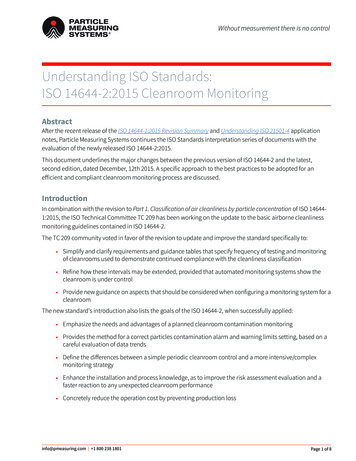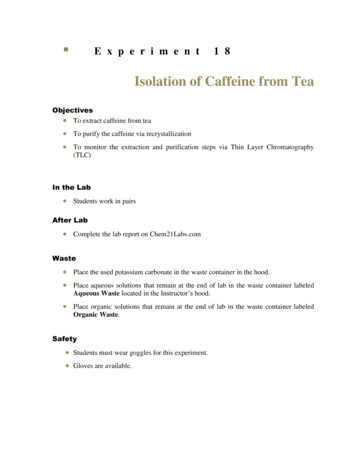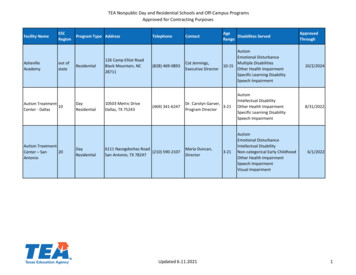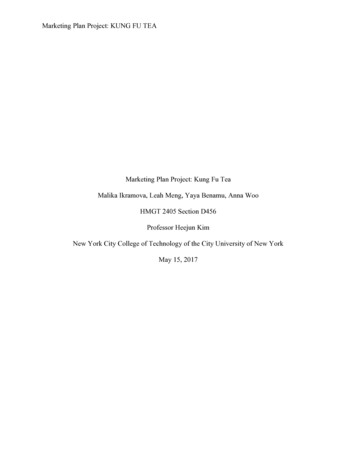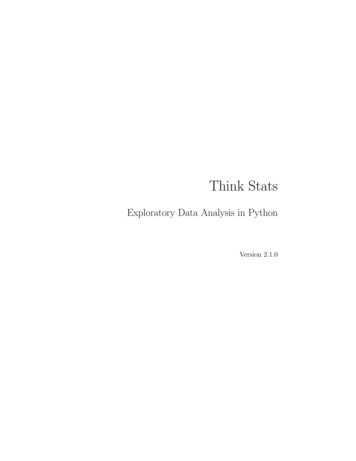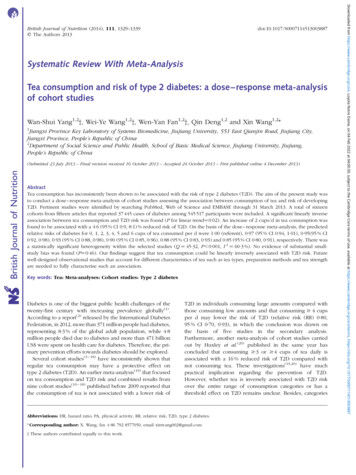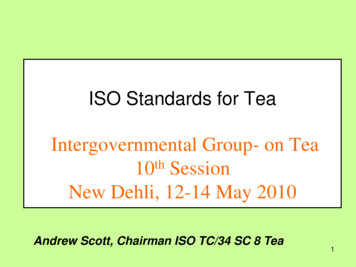
Transcription
ISO Standards for TeaIntergovernmental Group- on Tea10th SessionNew Dehli, 12-14 May 2010Andrew Scott, Chairman ISO TC/34 SC 8 Tea1
2
TeaOver 3 million tonnes producedIn over 30 countriesProviding over 1000 billion cups of tea3
International Standards for TeaInternational standards are vital to facilitate international tradeTo ensure consumer expectations are metTo provide guidance and common understanding of GoodManufacturing practices via compositional specificationsTo provide validated methods of analysis4
International Standards for Tea1970’s - Tea Committee became ISO Working Group 8- ISO Technical Committee 34 Sub-committee 8 – Tea1977 - ISO 3720 Black tea standard8 testing methods to measure basic tea parameters1980 - ISO 1839 Sampling tea1980 - ISO 3103 Preparation of liquor for sensory analysis1982 - Glossary of terms1990 - Instant tea standard4 supporting test methods5
. why measure polyphenols in tea?6
ISO BLACK TEA SPECIFICATION - ISO 3720 1977 (First edition)“INTRODUCTIONThe content of CAFFEINE and the content of POLYPHENOLIC constituents areimportant chemical characteristics of black tea, but it has not been possible toinclude limits for either of them in the specification. In the case of CAFFEINE,agreement has not yet been reached on a standard method for thedetermination.In the case of POLYPHENOLIC CONSTITUENTS, knowledge abouttest methods is not sufficiently developed to justify the standardization of any oneof the methods in existence; moreover, information on the content of theseconstituents is only available for a few types of tea.”7
Tea & International Standards1995- Measurement of caffeine in tea and instant tea- Measurement of caffeine in tea, instant tea anddecaffeinated tea2005- Measurement of total polyphenols in tea2005- Measurement of catechins in green (and black) tea8
Substances Characteristic of Tea(15th Meeting ISO/TC 34/SC 8, 1992)ObjectivesFurther development of methods for catechins and totalpolyphenols in green teasObtain catechin and total polyphenols data on a range ofgreen teas representative of those in international tradeExamine the applicability of these methods for black andoolong teas to facilitate discrimination from greenAlsoCatechin data is needed for the study of the healthbenefits of tea9
Measuring PolyphenolsThe methods should be:- Capable to be used by all scientists in producer & consumercountries- Produce reproducible results within a laboratory- Produce reproducible results between laboratories- A validated method of analysis10
Measuring Total PolyphenolsFolin Denis reagent established as phenol reagent to quantifytyrosine in proteins, vanillin in vanilla and method of choice forestimating mono- and poly- phenolic molecules in plant foods.Issues:- phenols approximately 50% ionised at pH 9-10- precipitate with increasing reagent or sodium carbonate concentration or both- Beer Lambert Law not strictly followed- saturated sodium carbonate: variation with temperature, equilibration not rapid- Timing of adding reagents important- Temperature and other factors affect the blue colour formation- distilling at high altitude (Kenya tea estate) not equivalent to London / Colworth- empirical methodFirst trial evaluated the Folin Denis reagent:– variability due to making up the reagent11
Measuring Total PolyphenolsFolin Ciocalteu reagent similar to Folin Denis reagent and isavailable commerciallyAdvantages FC over FD:- no precipitation except in excess potassium- more intense and more stable blue colour- no difficulties in preparation – off the shelf.- gives less colour in proportions to that of FD for possible interfering reductants[high content of active oxidant in FC promoting more complete oxidation andmeasurement of more slowly reacting phenolics?]12
Measuring Total PolyphenolsAgreed to base test on a method published by Singleton & Rossi(1965) using the Folin-Ciocalteu reagentTest was developed by a working group of 4 laboratoriesTrials:#12 black (Kenya & Argentina) and 1 green (China) teas#22 black (Kenya & Argentina) and 1 green (China) teas13
Measuring Total PolyphenolsFirst International ring trial - 20 participating laboratories:- showed promising results- identified that training was required for good precision- improvements to protocol required- add a training set of samplesIssues:- sodium carbonate solution:- saturated (Folin Denis) to 20% (Singleton & Rossi 1965)- high blanks- mixing of reagents- timings of additions- colour development time (FC vs FD)- age & batch of reagent differences?- laboratory temperature- extraction - volume variation / extraction recovery for catechins & flavonoids?14
Measuring Total PolyphenolsExtraction:Total Polyphenol & Catechin Analysis- tea must be finely ground ( 0.5mm)- small but representative sample of ground tea (0.2g)- exhaustive double extraction with hot (70 C) 70% methanol give high yield andlow catechin degradation- extract samples are stable at 4 C for 24 after preparationNote:- disposable plastic tubes are easier and more reliable to use than re-useableglassware to eliminate trace contamination etc.15
Measuring Total PolyphenolsSecond International ring trial - 24 participating laboratories:- within laboratory repeatability without exception improved- between laboratory reproducibility values similar to 1st trial16
Measuring Total Polyphenolsy 0,0132x 0,011317
Green leaf tea - ChinaTotalPolyphenols%onDM30Mean 24.5252015105012345678910 11 12 13 14 15 16 17 18 19 20 21 22 23 24Laboratory NumberBlack leaf tea - KenyaTotal 30Polyp 25henols 20%on15DMMean 18.8105012345678910 11 12 13 14 15 16 17 18 19 20 21 22 23 24Laboratory NumberTotalPolyphenols%onDMBlack leaf tea - Argentina30Mean 13.9252015105012345678910 11 12 13 14 15 16 17 18 19 20 21 22 23 24Laboratory Number18
Measuring Total Polyphenols19
Measuring Total PolyphenolsTotal extraction of polyphenols:ISOBlack tea – 14.63% on dry matter basis (54 samples)Green tea – 17.29% on dry matter basis (102 samples)University of Braunschweig studyBlack teas:UKIntl AIntl BUSA14.92%14.61%15.14%15.29%UK Tea Trade database:557 mg/l polyphenols in a brewed cup of tea (71 samples)20
21
Measuring CatechinsThe method should be:- Capable to be used by all scientists in producer & consumercountries- Fit for the purpose- Produce reproducible results within a laboratory- Produce reproducible results between laboratories22
Measuring CatechinsUses HPLC to separate the constituents and measures the UVabsorbance of the individually separated catechinsSamples – Stage 1 instant teas – 1 green & 1 black- Stage 2: 2 green teas [China sm lf & China bold lf]2 black teas [Darjeeling Snowview & Lingia]Remove all variation other than laboratory testing:- the same columns used (Unilever prep)[Phenomenex Luna 5 m Phenyl-Hexyl 250x4.6mmGuard 4x3mm Phenyl-Hexyl guard]with Phenomenex Security- pure catechin standards used (Unilever)23- tea samples ground to powder and mixed to homogeneity
Measuring CatechinsExtraction- same as Total Polyphenol AnalysisHPLC conditions- HPLC with Luna Phenyl-Hexyl column improves resolution of catechinscompared with C18- UV wavelength detection (278 nm)- Temperature control to 35 C to maintain resolution and prevent drifting peaks-Solvent gradient 2% acetic acid - acetonitrile with EDTA; Acetonitrile 9-32% over15mins- Samples for analysis are diluted in stabilising solution containing EDTA andascorbate in acetonitrile- Oxidation (metal catalysed or otherwise) must be avoided for reproducible results24in dilute solutions
Measuring CatechinsTest was developed by a working group of 4 laboratories#1 International ring trial - 17 laboratories participated :16 results were returnedIssues:- adequate within laboratory - variability between laboratories- recalculation of data using consensus relative response factors improvedrepeatability- RRF’s viable approach for quantitation of catechins[pure catechins – not readily available, impure and very costly]- variability most likely due to degradation during chromatography (metalcontamination) - include EDTA in mobile phase25
Measuring Catechins#2 International ring trial- 17 laboratories participated:14 results were returnedStatistical methods: Cochrane test (duplicates), Dixon test (between laboratories),Friedman test (consistent highs/lows)Relative response factor relative to caffeine std (more convenient retention timethan gallic acid)Standard purity assessments [ HPLC, NMR, moisture]26
Measuring CatechinsComparison of statistical analysis results on recalculated RRF’svs Laboratory’s calibrations:- total catechin values lower as a consequence of using standard RRF’sexpressed on dry matter basis- an improvement on repeatability values with RRF recalculated data set- a marginal improvement in reproducibility in 3 out of the 4 teas with theRRF re-calculated data set.27
28
29
30
Green Leaf Tea - Sample 1Green Leaf Tea - Sample 22525Mean 14.0Mean 17.420%Catechins on DM%Catechins on boratory No.8910111213141617Black Leaf Tea - Sample 4Black Leaf Tea - Sample 32525Mean 8.2Mean 10.82020%Catechins on DM%Catechins on DM15Laboratory No.15105151050012345678910Laboratory ry No.31
Measuring Catechins32
Measuring Catechins33
Measuring Catechins34
Measuring CatechinsTotal catechin content:ISOBlack tea 1Black tea 2Green tea 1Green tea 2––––8.93% on dry matter basis6.81% on dry matter basis12.14% on dry matter basis14.78% on dry matter basisWithin laboratory repeatability of the analysis is good (9)Between laboratory reproducibility has larger variation but this isto measure 5 constituents (9)35
Measuring CatechinsConclusions:- method adequately repeatable within laboratory- largest contribution to total variance comes from between laboratories[analysis of 7 constituents]- recalculation of data using consensus RRF’s improved the repeatabilitybut only a marginal improvement on reproducibility- variance from some laboratories - degradation of catechins - takeprecautions [EDTA already added to mobile phase]36
37
ConclusionsTwo Internationally validated methods analysis for measuring(i) total polyphenols and (ii) catechins in leaf or instant tea arenow available.These methods can be adapted to measure polyphenol &catechins in tea brews38
RecommendationCommend these robust methods of analysis for routine use in themeasurement of polyphenols in tea.Tea trade & academics in each country goes about collectingdata on teas available in the trade to generate typical values ofpolyphenols in teaAgree with regulatory authorities the appropriate use of typicalpolyphenol content in teas with consumers (marketing, on packetc)39
ReferencesSingleton, V.L., Orthofer,R. and Lamuela-Raventos, R.M. Analysis of totalpolyphenolics and other oxidation substrates and antioxidants by means ofFolin-Ciocalteu reagent. In: Methods in Enzymology. Oxidants andAntioxidants, Part A,Lester Packer, ed. (1999), 299, pp. 152-178.ISO/TC 34/SC 8 – Tea N513, Report from the project leader of the ISO ring test onISO/CD 14502-2 (Tea – Methods for determination of substancescharacteristic of green and black tea – Part 2: Determination of catechins ingreen tea – Method using high performance liquid chromatography).40
Current ProjectsPublication of polyphenol data in green and black teaGreen tea specificationBlack tea specification revisionWhite Tea specificationTheanine measurement in tea41
AcknowledgementsDr Peter Collier ex-Chairman ISO TC 34/SC 8 - TeaClive Dacombe - UnileverProfessor Ulrich Engelhardt – University of BraunschweigKatie Donnelly – TetleyDr Andrew Lea – RSSLDr Conrad Astill - UnileverDr Jacek Obuchowicz42
43
3 Over 3 million tonnes produced In over 30 countries Pro

